
Maastricht (L) part 1/2
Maastricht
is one of the country's
oldest cities, already having been an urban settlement before the fall
of the Roman empire and having been permanently inhabited ever since. Bishop Servatius, the bishop of the
nearby, now Belgian, Tongeren, is
buried on the location of the current church of St. Servaas, which is
named after him. With this Servatius started Maastricht's history as a
bishop's town which would last until the 8th century, when the bishop
moved his court to Luik (Liège in Belgium), although the bishops
kept their claims on the city.
In 1204 the king of Germany handed Maastricht over to the possession of
the duke of Brabant. After numerous conflicts in 1284 it was settled
that the city in the future was to be ruled in unison by both the duke
and the bishop. Maastricht changed owners many times since. It was
besieged and attacked a few times, but despite its turbulent history
many historical buildings have survived. Maastricht is second
on the list of cities in the Netherlands with the biggest number of
monumental buildings. More than any other city in the
Netherlands, Maastricht's churches represent the evolution in church
architecture in the past 1000 years.
In
1920 Maastricht's territory was expanded with large parts of the surrounding
municipalities, including the villages Sint Pieter,
Limmel, Heugem, Caberg and Wolder, and in 1970 with Amby, Heer,
Scharn, Itteren and Borgharen. Only the latter two are still seperate
villages, although like the others they are officially part of the city.
This very page deals with the church within the historic borders of Maastricht. Churches in the (former) villages and neighbourhoods outside the center are on page two.
Maastricht is een van de oudste steden van het land, en was al een
stedelijke nederzetting voor de val van het Romeinse rijk. Sindsdien is de
plaats continu bewoond geweest. Bisschop Servatius, de bisschop van het nabije, nu Belgische, Tongeren, is
begraven op de locatie van de huidige kerk van St. Servaas, die naar
hem is vernoemd. Met deze Servatius begon voor Maastricht een
traditie als bisschopszetel die zou duren tot de 8ste eeuw, toen de
bisschop zijn hof verplaatste naar Luik, hoewel de bisschoppen hun
aanspraken op de stad bleven doen gelden. In 1204 deed de
koning van Duitsland Maastricht over aan de hertog van Brabant. Na
talrijke conflicten tussen Brabant en het bisdom Luik werd in 1284
geregeld dat de stad in de toekomst zou worden geregeerd door zowel de
hertog en de bisschop. Maastricht wisselde hierna vele malen van
eigenaar. Het was aangevallen, belegerd en veroverd, maar ondanks de
roerige geschiedenis zijn veel historische gebouwen bewaard gebleven.
Maastricht is de tweede op de lijst van steden in Nederland met het
grootste aantal monumentale gebouwen. Meer dan enige andere
stad in Nederland, illustreren de kerken in Maastricht de ontwikkeling
in de kerkelijke architectuur in de afgelopen 1000 jaar.
In 1920 werd het grondgebied van Maastricht uitgebreid met de dorpen
Sint Pieter, Limmel, Heugem, Caberg en Wolder, terwijl in 1970 ook
Amby, Heer, Scharn, Itteren en Borgharen aan de gemeente werden
toegevoegd. Alleen de laatste twee zijn nog steeds aparte
dorpen, maar net als de anderen maken ze officieel deel uit van de
stad.
Deze pagina behandelt alleen de kerkgebouwen binnen de historische grenzen van Maastricht. Kerken in de (voormalige) dorpen en buurten buiten het centrum staan op pagina twee.
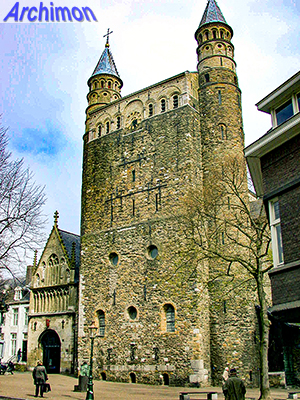
An important example of Romanesque architecture is the Onze-Lieve-Vrouwekerk (Church of Our Lady), which has an impressive westwork which obviously once served defencive purposes. Parts of it were build using stones from the former Roman castellum. This is the oldest church in Maastricht.
Location: O.L. Vrouweplein 9
Een belangrijk voorbeeld van romaanse architectuur is de Onze-Lieve-Vrouwekerk die een indrukwekkend westwerk heeft, een brede versterkte toren die duidelijk defensieve doeleinden diende. Delen ervan zijn gebouwd met stenen van het voormalige Romeinse castellum. Dit is de oudste kerk in Maastricht.
Locatie: OL Vrouweplein 9
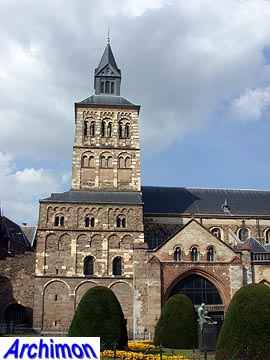
Just like the Church of Our lady the St. Servatius, also often called St. Servaas, is essentially a church built in a Romanesque style and also has a westwork. The St. Servatius however has seen significant changes in Gothic style, like the side-aisles and transept.
Location: Keizer Karelplein 6
Net als Onze-Lieve-Vrouwkerk is de St. Servatius in wezen een kerk in romaanse stijl met eveneens een westwerk. De kerk heeft echter significante uitbreidingen in gotische stijl ondergaan, zoals de zijbeuken en het transept.
Locatie: Keizer Karelplein 6
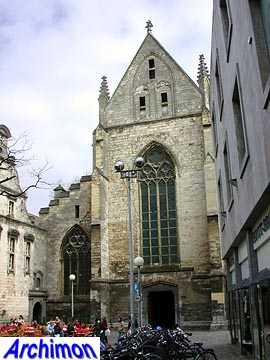
The former Dominican church is one of the oldest Gothic churches in The Netherlands. It dates from the 13th century. It's nowadays a bookstore.
Location: Dominikanerkerkstraat 1
De voormalige Dominicanenkerk is een van de oudste gotische kerken in Nederland. Het dateert uit de 13e eeuw. Het gebouw huisvest tegenwoordig een boekhandel.
Locatie: Dominikanerkerkstraat 1
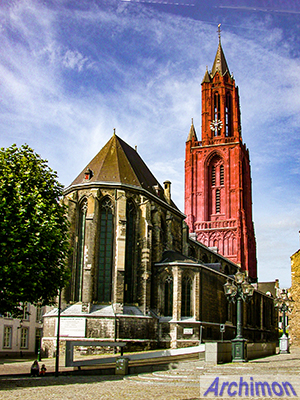
Standing next
to the St. Servatius is the Gothic
St. Jan, which was originally built
as a baptistry of its neighbour. It became a protestant church in 1632,
when the city's four parish-churches were equally divided between the
Calvinist minority and the Catholic majority, under pressure
of a military occupation by troops of the protestant Republic. The
church is in Mosan Gothic style, but the tower was greatly influenced
by that of the cathedral in Utrecht.
Location: Vrijthof 24
Naast de St. Servatius staat de St. Jan, een gotische kerk die oorspronkelijk werd gebouwd als doopkapel van zijn buurman. Het werd een protestantse kerk in 1632, toen de vier parochiekerken van de stad gelijk werden verdeeld tussen de calvinistische minderheid en de katholieke meerderheid, onder druk van een militaire bezetting door troepen van de protestantse Republiek. De kerk is in Maasland-gotische stijl, maar de toren werd sterk beïnvloed door de Domtoren in Utrecht.
Locatie: Vrijthof 24
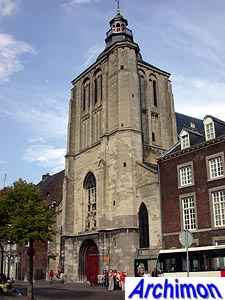
The St. Matthias dates from the 14th century, with several parts added in the following centuries. As is very usual in this part of the country, most of the church is is constructed using marl from one of the nearby marl pits. This is one of two parish-churches handed over to the protestants in 1632, but it has returned in catholic hands long ago.
Location: Boschstraat 99
De St. Matthias dateert uit de 14e eeuw, maar werd in de volgende eeuwen enkele malen uitgebreid. Zoals zeer gebruikelijk in dit deel van het land, is de kerk voor het grootste deel gebouwd uit mergel uit een van de nabijgelegen mergelgrotten. Dit is een van de twee parochiekerken die in 1632 werden overgedragen aan de protestanten, maar de kerk keerde het is teruggekeerd in katholieke handen te lang geleden.
Locatie: Boschstraat 99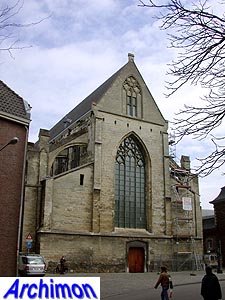
The Eerste Minderbroederskerk, which in English roughly translates to 'First Franciscan friars church', has an appearance very similar to the Dominicans church, and dates from the same period. The order of the Franciscan friars was expelled from the city twice, and this building has been used as a barracks for a long time. In 1880 monastery and church were given their current function of provincial archive. A second Minderbroederskerk was built in the 17th century elsewhere in the city.
Location: Sint Pieterstraat 5
De Eerste Minderbroederskerk is qua uiterlijk vergelijkbaar met de Dominicanenkerk en dateert uit dezelfde periode. De Franciscaner broeders werden twee keer verdreven uit de stad twee keer, en de kerk werd lange tijd is gebruikt als kazerne. In 1880 kregen klooster en kerk kregen hun huidige functie van provinciaal archief. Een tweede Minderbroederskerk werd gebouwd in de 17de eeuw elders in de stad.
Locatie: Sint Pieterstraat 5
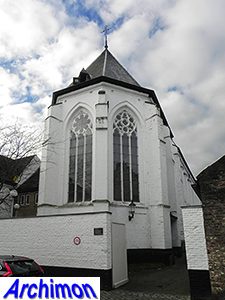
This white-painted apse belongs to the Nieuwenhof chapel, which was built in the 15th century as part of a convent which was situated just within the city-walls. The nave was renewed in Baroque style in the 17th century. Both convent and chapel are now part of the university.
Location: Zwingelput 4
Deze witgeschilderde koorsluiting behoort tot de Nieuwenhofkapel, die in de 15e eeuw werd gebouwd als onderdeel van een klooster dat net binnen de stadsmuren was gelegen. Het schip werd in de 17e eeuw in barokke stijl vernieuwd. Klooster en kapel behoren tegenwoordig tot de universiteit.
Locatie: Zwingelput 4
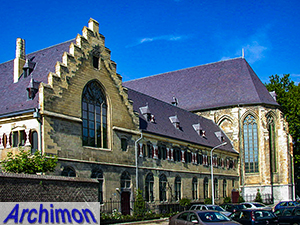
A rare example of a medieval monastery is the former Kruisherenklooster (crosier monastery) which has survived many centuries and is in a remarkably complete state. The complex forms a square around a courtyard, with the actual monastery forming three of its sides, and the monastery-church at the fourth side. The complex was recently rebuilt into a hotel.
Location: Kruisherengang 21
Een zeldzaam voorbeeld van een middeleeuws klooster is het voormalige Kruisherenklooster dat vele eeuwen heeft overleefd en in een opmerkelijk complete staat is. Het complex vormt een vierkant rondom een binnenplaats, waarvan het eigenlijke klooster drie zijden vormt, met de kloosterkerk als de vierde zijde. Het complex werd onlangs verbouwd tot een hotel.
Locatie: Kruisherengang 21
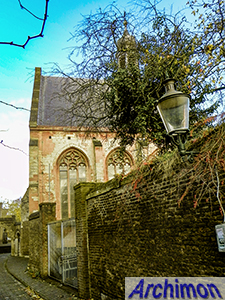
The Cellebroederskapel is the former chapel of an Alexian monastery. It's a small building in Gothic style and was built in ca.1512 while some alterations were made in the 18th century. The chapel is mostly used for cultural purposes.
Location: Cellebroedersgang
De Cellebroederskapel is de voormalige kapel van een Alexistisch klooster. Het is een klein gebouw in gotische stijl en werd rond 1512 gebouwd, terwijl er in de 18e eeuw enkele wijzigingen werden aangebracht. De kapel wordt vooral voor culturele doeleinden gebruikt.
Locatie: Cellebroedersgang
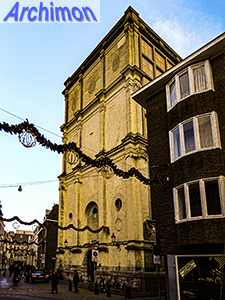
One of several churches in Baroque style built in Maastricht is the former Jesuite church. It was built in 1606-1614 and was designed by Jesuite architect P. Huyssens. After the Jesuite order was disbanded in 1773 the church was turned into a theatre. The original facade was mutilated in 1955.
Location: Achter de Comedie 1
Een van meerdere kerken in barokstijl in Maastricht is de voormalige Jezuïetenkerk. De kerk werd gebouwd in 1606-1614 en is ontworpen door de jezuiët P. Huyssens. Nadat de Jezuïetenorde in 1773 werd ontbonden, werd de kerk omgebouwd tot een theater. De originele gevel werd verminkt in 1955.
Location: Achter de Comedie 1
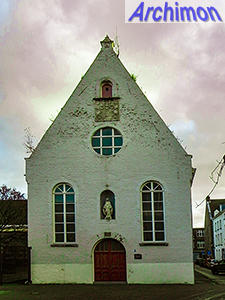
The Capuchin church is an aisleless church built in ca. 1615 as part of a Capuchin monastery founded a few years earlier. After a fire it was rebuilt in 1681. The monastery was closed in 1796 and its buildings were either demolished or given a new purpose. The church was used as an arsenal.
Location: Capucijnengang 6
De Capucijnenkerk is een zaalkerk die rond 1615 werd gebouwd als onderdeel van een kapucijnenklooster dat enkele jaren eerder wasgesticht. Na een brand werd de kerk in 1681 herbouwd. Het klooster werd in 1796 gesloten en de gebouwen werden gesloopt of kregen een nieuwe bestemming. De kerk werd gebruikt als arsenaal.
Locatie: Capucijnengang 6
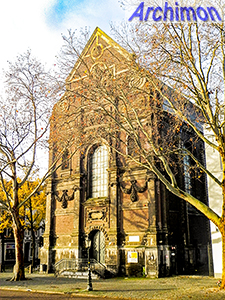
Also in Baroque style, but much better preserved, is the Augustijnenkerk (Church of the Augustinians) from 1659-1661. It is no longer in use as a church, and now serves a famous local choir as a rehearsal-room.
Location: Kesselskade 43
Ook in barokke stijl, maar veel beter bewaard, is de Augustijnenkerk uit 1659-1661. Het gebouw is niet langer in gebruik als kerk en dient nu als als repetitieruimte voor het koor Mastreechter Staar.
Locatie: Kesselskade 43
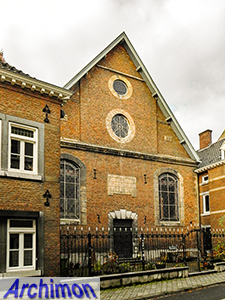
The Lutheran church is an aisleless church in simple Classical style, built in 1683-1684. It originally was a hidden church and was until 1936 blocked from view by a house in front of it. In 2013 the church was closed.
Location: Hondstraat 14
De Lutherse kerk is een zaalkerk in eenvoudige classicistische stijl en werd gebouwd in 1683-1684. Oorspronkelijk was het een schuilkerk, die tot 1936 door een huis voor de kerk aan het zicht werd onttrokken. In 2013 werd de kerk gesloten.
Locatie: Hondstraat 14
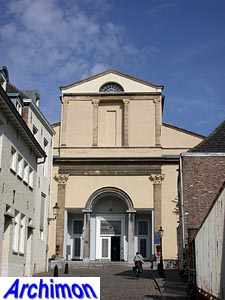
In c. 1700 the Tweede Minderbroederskerk (second Franciscan friars church), was built, after the Franciscans had returned to Maastricht. The church was completed in 1708. In 1825-1829 the church became a courthouse, and in 1995-1998 it was once again converted, this time to serve as part of the university.
Location: Minderbroedersberg 4-6
Rond 1700 werd de Tweede Minderbroederskerk gebouwd, nadat de franciscanen waren teruggekeerd naar Maastricht. De kerk werd voltooid in 1708. In 1825-1829 werd de kerk een gerechtsgebouw, en in 1995-1998 was het opnieuw verbouwd, dit keer om te dienen als onderdeel van de universiteit.
Locatie: Minderbroedersberg 4-6
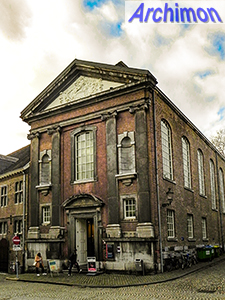
The Bonnefantenkerk, the church of the convent of the ‘Soeurs des Bons Enfants’ was built in 1708-1709 to a design in Classical style by Gilles Doyen. After the convent was closed in 1797 it served as a barracks and a museum and since 1979 is part of the university.
Location: Bonnefantenstraat 2
De Bonnefantenkerk, de kerk van het klooster van de 'Soeurs des Bons Enfants' werd in 1708-1709 gebouwd naar een ontwerp in classicistische stijl van Gilles Doyen. Na de sluiting van het klooster in 1797 diende het als kazerne en museum en maakt sinds 1979 deel uit van de universiteit.
Locatie: Bonnefantenstraat 2
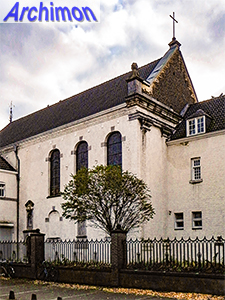
The church of the Franciscan convent and hospital Calvariënberg was built in 1710. The convent was closed in 1796 but the hospital remained. In 1847 a new extension was added to the front of the church, largely blocking the Classical facade.
Location: Calvariestraat
De kerk van het Franciscanessenklooster en ziekenhuis Calvariënberg werd gebouwd in 1710. Het klooster werd in 1796 gesloten maar het ziekenhuis bleef behouden. In 1847 werd een nieuwe uitbreiding toegevoegd aan de voorzijde van de kerk, waarachter de Classicistische gevel grotendeels verdween.
Locatie: Calvariestraat
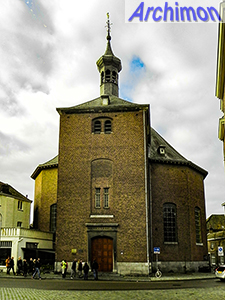
The Walloon church dates from 1732-1733. It consists of a centralized space of twelve sides and a simple tower of about the same height as the church itself. It was designed by Thomas Comhaire, an architect from Luik/Liège, and replaced a medieval chapel which had stood on this location and had been used as a Walloon church previously.
Location: Sint Pieterstraat 6
De Waalse kerk dateert 1732 tot 1733. Het bestaat uit een centrale ruimte van twaalf zijden en een eenvoudige toren van ongeveer dezelfde hoogte als de kerk zelf. Het werd ontworpen door Thomas Comhaire, een architect uit Luik / Liège, en vervangen door een middeleeuwse kapel had gestaan, die op deze locatie en werd gebruikt als een Waalse kerk eerder.
Locatie: Sint Pieterstraat 6
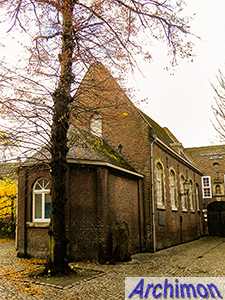
The
chapel of the Grauwzustersklooster, a convent
of a Franciscan lay women's order, was built in ca. 1750 and is in Mosan
Rernaissance style. The convent was closed already in 1797 and served many
purposes since. In 1920 the entire complex became a museum of natural history.
Location: De Bosquetplein 6
De kapel van het Grauwzustersklooster, het klooster van een Franciscaanse vrouwelijke
lekenorde, werd rond 1750 gebouwd en is in Maaslandse renaissancestijl. Het klooster werd al in 1797 gesloten en diende sindsdien vele doelen. In 1920 werd het hele complex een natuurhistorisch museum.
Locatie: De Bosquetplein 6
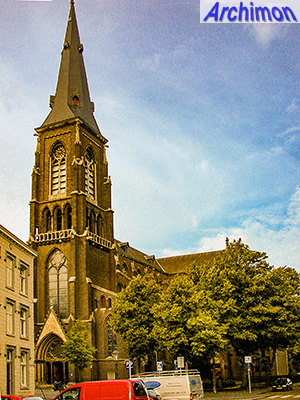
The St. Martinus in the Wyck neighbourhood is one of architect P.J.H. Cuypers' earlier works and dates from 1857-1858 and replaced an older church. The church is similar to many of Cuypers' earliest churches, being a cruciform basilica with a tower, all in a neo-Gothic style inspired by early French Gothicism.
Location: Rechtstraat 2
De St. Martinus in de buurt Wyck is een vroeg werk van architect P.J.H. Cuypers, dateert uit 1857-1858 en verving een oudere kerk. De kerk is, net als veel van de vroegste kerken van Cuypers, een kruisbasiliek met een toren, in een neogotische stijl geïnspireerd door de vroege Franse gotiek.
Locatie: Rechtstraat 2
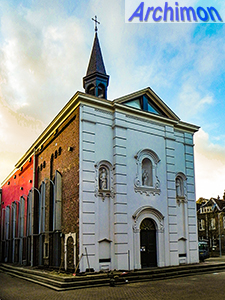
The chapel of the Capucijnenhof was built in 1885 in a then already archaic neo-Classical style as part of a monastery of the Brothers of Maastricht (Brothers FIC) who in 1911 were succeeded by Franciscan nuns. In 1992-1995 the entire complex, church included, was rebuilt into apartments.
Location: Capucijnengang 3
De Capucijnenhofkapel werd in 1885 in een toen al archaïsche neoclassicistische stijl gebouwd als onderdeel van een klooster van de Fraters van Maastricht (Fraters FIC) die in 1911 werden opgevolgd door Franciscaanse nonnen. In 1992-1995 werd het gehele complex, inclusief de kerk, verbouwd tot appartementen.
Locatie: Capucijnengang 3
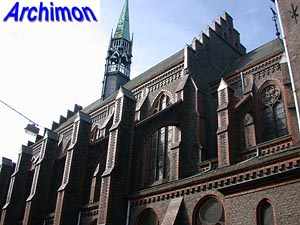
The
chapel of the Ursuline
convent was designed by J. Kayser and is in a neo-Gothic style that
is
typical
for much of his work, being influenced by Gothic brick architecture of
Northern Germany. The chapel was built in 1890.
Location: Capucijnenstraat 122
De kapel van het Ursulinenklooster werd ontworpen door J. Kayser en is in een neogotische stijl die typisch is voor veel van zijn werk, en sterk werd beïnvloed door de gotische baksteenarchitectuur van Noord-Duitsland. De kapel werd gebouwd in 1890.
Locatie: Capucijnenstraat 122
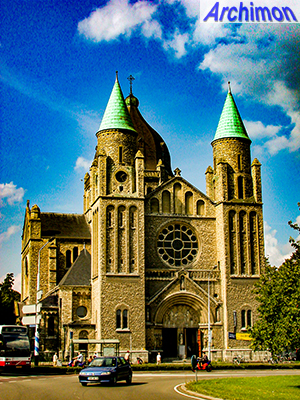
The St. Lambertuskerk was the first church that was built outside the 14th-century city-walls. This impressive church in neo-Romanesque style was designed by architect J.H.H. van Groenendael and built during the First World War.
Location: Koningin Emmaplein 7
De St. Lambertus was de
eerste kerk die werd gebouwd buiten de
14e-eeuwse stadsmuren. Deze indrukwekkende kerk in neoromaanse stijl
werd ontworpen door architect J.H.H. van Groenendael en gebouwd tijdens
de
Eerste Wereldoorlog.
Locatie: Koningin Emmaplein 7

The Sterrekerk or Sterrepleinkerk is former protestant church in Traditionalist style, built in 1926. Its architect was a J. Kortlang. The church was built for the Gereformeerden, but today is an artist's workshop.
Location: Sterreplein 2, Wyck
De Sterrekerk of Sterrepleinkerk is voormalige protestantse kerk in traditionalistische stijl, gebouwd in 1926. De architect was een zekere J. Kortlang. De kerk werd gebouwd voor de Gereformeerden, maar is tegenwoordig het atelier van een kunstenaar.
Locatie: Sterreplein 2, Wyck
Back to the Province of Limburg